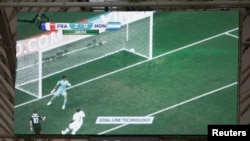RIO DE JANEIRO —
Goal or no goal? Computer programmers are rushing to avoid a repeat of the mixed signals sent out to viewers by soccer's new goalline technology during Sunday's World Cup Group E between France and Honduras.
The video technology, which was called upon for the first time at the World Cup, gave a verdict of “No goal” for a shot from France's Karim Benzema, which struck a post and came back across the face of the goal.
It then quickly announced “goal” after Honduran goalkeeper Noel Valladares inadvertently pushed the ball towards his own net and scrambled to clear it.
The match referee awarded the goal with the aid of the technology, giving France a 2-0 lead in the match which they eventually won 3-0.
A spokeswoman for FIFA, world soccer's governing body, said on Monday that the technology had worked correctly but tweaks would be made so it would give a single verdict in similar situations in the future.
“What we are now doing is working to make it even more clear and we will modify guidelines on the key relevant goalline technology animations in cases such as yesterday so that you just see a goal sign,” she said.
Former Brazil striker Zico said he favored the use of technology to help prevent wrong decisions ruining games.
“You can't work for three years [preparing for a World Cup] and suddenly you find you've scored a good goal that is ruled out,” he said. “I think this is very important for football.”
The system, provided by German company GoalControl, involves 14 high-speed cameras located around the pitch, with seven cameras focusing on each goalmouth.
The video technology, which was called upon for the first time at the World Cup, gave a verdict of “No goal” for a shot from France's Karim Benzema, which struck a post and came back across the face of the goal.
It then quickly announced “goal” after Honduran goalkeeper Noel Valladares inadvertently pushed the ball towards his own net and scrambled to clear it.
The match referee awarded the goal with the aid of the technology, giving France a 2-0 lead in the match which they eventually won 3-0.
A spokeswoman for FIFA, world soccer's governing body, said on Monday that the technology had worked correctly but tweaks would be made so it would give a single verdict in similar situations in the future.
“What we are now doing is working to make it even more clear and we will modify guidelines on the key relevant goalline technology animations in cases such as yesterday so that you just see a goal sign,” she said.
Former Brazil striker Zico said he favored the use of technology to help prevent wrong decisions ruining games.
“You can't work for three years [preparing for a World Cup] and suddenly you find you've scored a good goal that is ruled out,” he said. “I think this is very important for football.”
The system, provided by German company GoalControl, involves 14 high-speed cameras located around the pitch, with seven cameras focusing on each goalmouth.












